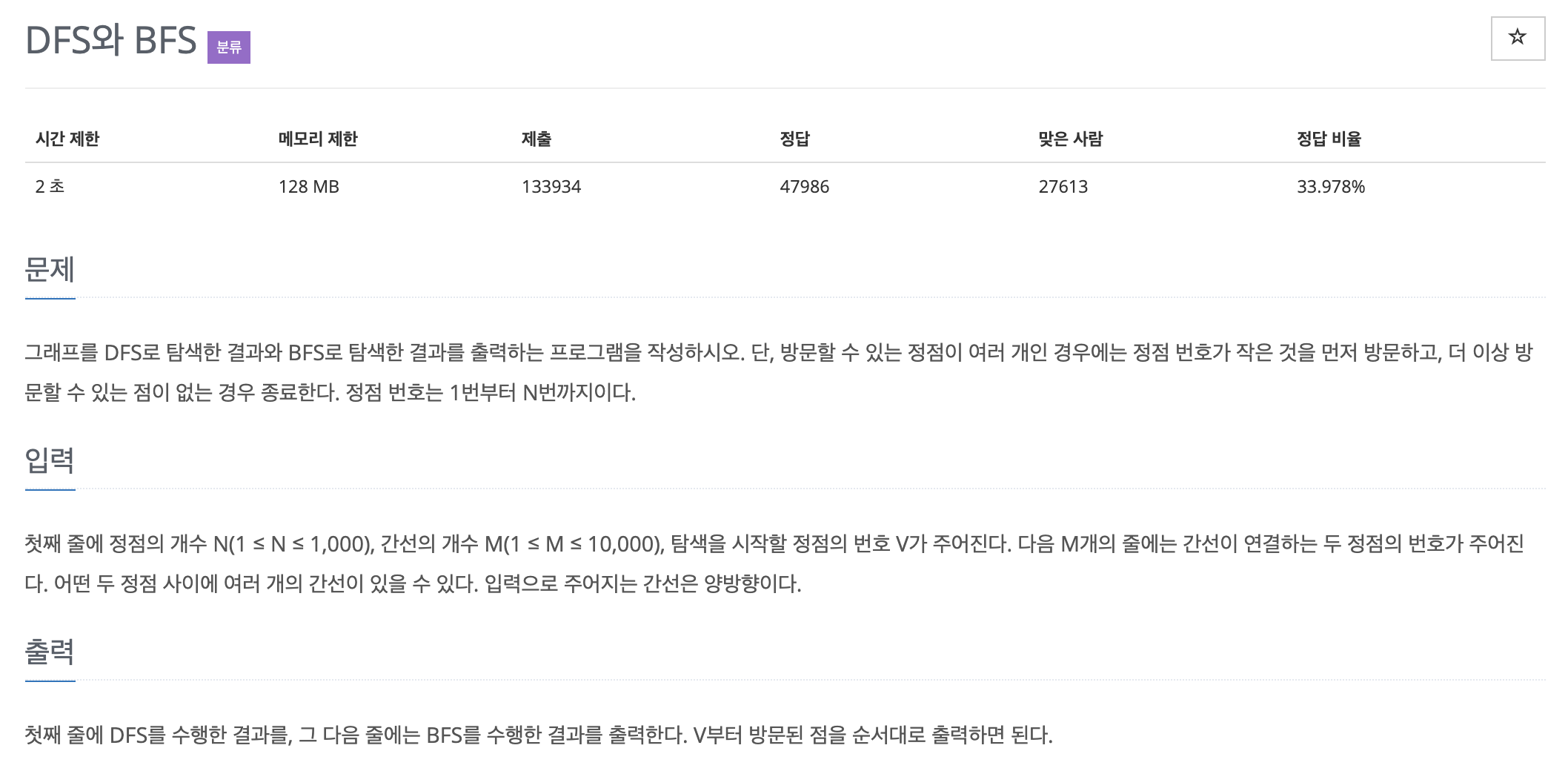Baekjoon Online Judge
algorithm practice
- 단계별 문제풀기
24. DFS와 BFS
그래프를 순회하는 알고리즘을 배워 봅시다.
Java / Python
1. DFS와 BFS
DFS와 BFS를 다루는 문제

이번 문제는 그래프를 DFS로 탐색한 결과와 BFS로 탐색한 결과를 출력하는 프로그램을 작성하는 문제입니다. 단, 방문할 수 있는 정점이 여러 개인 경우에는 정점 번호가 작은 것을 먼저 방문하고, 더 이상 방문할 수 있는 점이 없는 경우 종료해야 합니다.
DFS(Depth-First Search) : 깊이 우선 탐색
- 재귀나 스택으로 구현
- 특정 노드에서 시작해 다음 분기로 넘어가기 전에 해당 분기를 완벽하게 탐색하는 방법
BFS(Breath-First Search) : 너비 우선 탐색
- 큐로 구현 (FIFO원칙으로 탐색)
- 시작 정점으로부터 가까운 정점을 먼저 방문하고 멀리 떨어져 있는 정점을 나중에 방문하는 순회 방법
- Java
import java.io.*;
import java.util.*;
public class Main {
static int[][] arr;
static boolean[] check;
static StringBuilder sb = new StringBuilder();
public static void main(String[] args) throws IOException {
BufferedReader br = new BufferedReader(new InputStreamReader(System.in));
BufferedWriter bw = new BufferedWriter(new OutputStreamWriter(System.out));
StringTokenizer st = new StringTokenizer(br.readLine());
int N = Integer.parseInt(st.nextToken()); // 정점 개수
int M = Integer.parseInt(st.nextToken()); // 간선 개수
int V = Integer.parseInt(st.nextToken()); // 탐색을 시작할 정점의 번호
arr = new int[N + 1][N + 1];
check = new boolean[N + 1];
// 노드 , 간선 값 초기화
for(int i = 0; i < M; i++){
st = new StringTokenizer(br.readLine());
int s = Integer.parseInt(st.nextToken());
int e = Integer.parseInt(st.nextToken());
arr[s][e] = 1;
arr[e][s] = 1;
}
dfs(V);
sb.append("\n");
bfs(V);
bw.write(sb + "\n");
bw.flush();
bw.close();
br.close();
}
public static void initC(){
for(int i = 0 ; i < check.length; i++) check[i] = false;
}
public static void dfs(int st) {
sb.append(st + " ");
check[st] = true;
for (int i = 1; i < check.length; i++) {
if (i != st && !check[i] && arr[st][i] == 1)
dfs(i);
}
}
public static void bfs(int st){
initC();
Queue<Integer> queue = new LinkedList<Integer>();
queue.add(st);
check[st] = true;
while(!queue.isEmpty()) {
int temp = queue.poll();
sb.append(temp + " ");
for(int i = 1; i < check.length;i++) {
if(i != temp && !check[i] && arr[temp][i] == 1) {
queue.add(i);
check[i] = true;
}
}
}
sb.append("\n");
}
}- Python
import sys
N, M, V = map(int, sys.stdin.readline().split())
arr = [[0]*(N+1) for _ in range(N + 1)]
check = [0 for _ in range(N + 1)]
def dfs(v):
print(v, end=' ')
check[v] = 1
for i in range(1, N + 1):
if check[i] == 0 and arr[v][i] == 1:
dfs(i)
def bfs(v):
queue = [v]
check[v] = 0
while(queue):
v = queue[0]
print(v, end=' ')
del queue[0]
for i in range(1, N + 1):
if check[i] == 1 and arr[v][i] == 1:
queue.append(i)
check[i] = 0
for i in range(M):
s, e = map(int, sys.stdin.readline().split())
arr[s][e] = 1
arr[e][s] = 1
dfs(V)
print()
bfs(V)